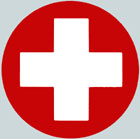 Credit:
Roundels
of the world
Credit:
Roundels
of the worldRoundel
The Northrop F-5 Enthusiast Page - Home
Flieger-
und Fliegerabwehr Truppen
/
Troupes
d'Aviation Suisse
/
Truppe
d'aviazone svizzere
Aviation and Antaircraft Troops
- till
31-12-95
Schweizer
Luftwaffe
/
Forces
Aériennes Suisse
/
Forze
aeree svizzere
Swiss Air Force
-
from
01-01-96
 Credit:
Roundels
of the world
Credit:
Roundels
of the world
Roundel
Last update 05-02-2024
SELECTION
/
PRODUCTION
/
SERVICE
INTRODUCTION
The
first evaluation of the Northrop F-5 was in June 1967, versions F-5A/F-5B,
competeing against the LTV A-7A Corsair and the Douglas A-4M as a
fighter-bomber but any decision was postponed to
a later (unknown) time.
The
year 1972 saw a new selection round to replace the remaining Hawker
Hunter; Saab J-37, McDonnell F-4, GAMD Mirage F.1 and the Northrop F-5E
Tiger participated to it. Air support capabilities were
abandoned in
favour of a local air superiority at low and medium altitudes (up to
6'000m), interception/ground attack being secondary functions. The
Tiger was from the very beginning the preferred aircraft,
particularily in view of its militia suitability.
Evaluation during 1973 involved an in-depth scrutinity of the Tiger; two Swiss test pilots went in the autumn to the USA for a pre-evaluation, following which Swiss in-country tests were requested.
These started
on 08-08-74 with the arrival at Emmen AB
of 1 Lockheed C-130 transporting ground equipment/personnel for the two
aircrafts (serials 71-01421/72-01386) destined to start trials on
12-08-74 at
Emmen AB, completed by September 23rd 1974. On
September 30th they left for Ramstein AFB.
Actual
testing lasted two weeks; it included 62 flights fomm Emmen AB, Meiringen AB and
from St. Stephan AB. Five Swiss pilots had been trained between
mid-June and mid-July at Williams AFB for a total of 18.55 hours
on
Northrop F-5B and 25.21 hours on the Tiger; four other pilots
(including a militia one) were checked out in Switzerland on the
single-seaters.
Mock air-combats were engaged against an Hawker
Hunter Mk.58 and an Mirage IIIS; cannon firings against a target
towed by an Hawker Hunter as well as against the wreck of a grounded
de Havilland Venom.
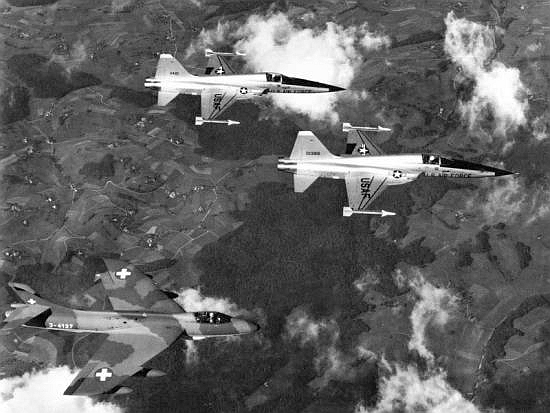
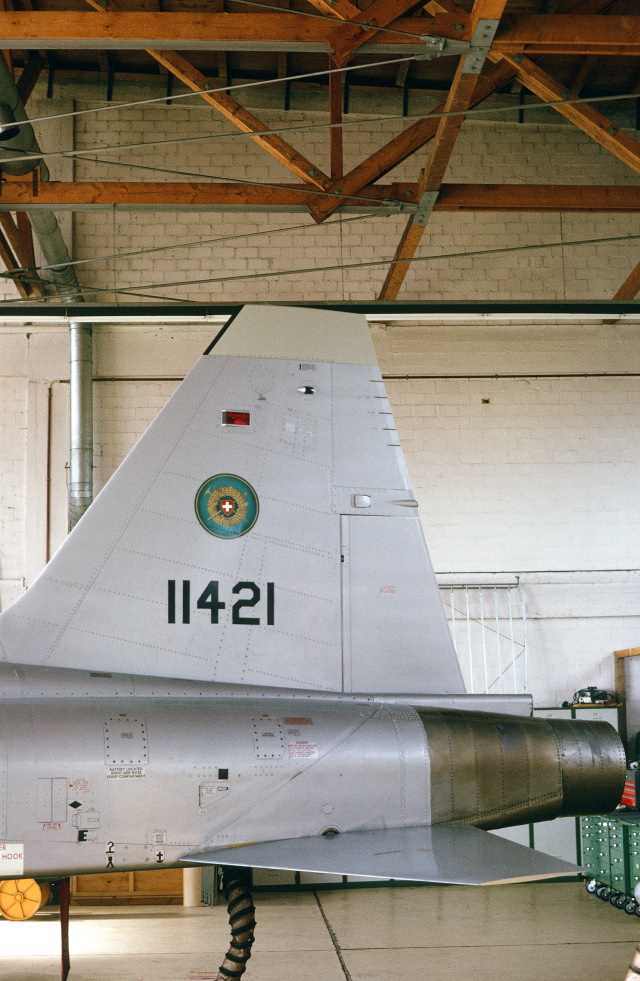 Archive: Franz Wegmann
Archive: Franz Wegmann
Northrop F-5E's 01421/01386 together with
Hawker Hunter Mk.58A J-4157
High
mountain Alpine insignia worn on the
fin by Northop
over
Central Switzerland
Photos: Swiss AF
F-5E serial 11421 on 23-09-74 during Swiss trials.
Trials took place
at Emmen, Meiringen, St Stephan Airports. The last (seen above) was a
war base, only to be activated for repetition courses and in case
of war.
 Photo: Swiss AF
Photo: Swiss AF
Northrop F-5E manually pushed into a cavern
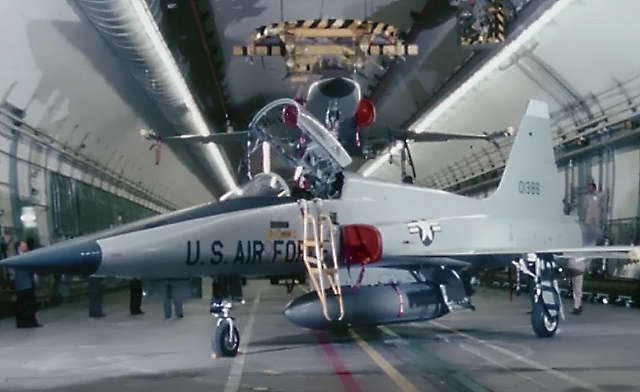

Northrop F-5E 01386 parked in the St Stephan AB cavern
during
trials, serial
Northrop F-5E 11421, next to seral 01386, being tugged out of the cavern
11421 already fastened to
the
top
Photos: Swiss AF
No
decision had been taken at this time wether to re-equip 4 or 5
Squadrons, needing 60 or 80 aircrafts (some of them two-seaters) and
if to build or assemble the aircraft under licence in Switzerland.
Finally,
a decision
was made to buy 66 Northrop F-5E, 13 built by Northrop, the remainder
to be assembled by the local Federal Aircraft Factory
(Eidgenössischen Flugzeugwerk) at Emmen, plus 6 double-seaters
F-5F
built by Northrop. These were to re-equip four Hawker Hunter
Mk.58 equipped Squadrons of 12 aircrafts plus 3 reserves each.
Requested
modifications to the basic aircraft included a Rear Warning Radar,
instllation of a Swiss IFF system, antiskidding brakes, a fatigue
meter, an improved General Electric APQ-159 radar and, for
operation
from bases' montaneous caverns used as hangars, a
gaseous oxygen system as well as strenthening of wing hardpoints to
attach the aircraft to the cavern's roof.
Authorisation
for a credit of 1'170 millions Swiss Francs (ca USD 400m at the time)
was given by the Swiss parliament on 16-03-76; Foreign Military Sales
contract with the US Government (named "Peace Alps")
was signed on 30-03-76, the USAF being responsiblefor the
execution.
A
further contact between the Swiss Federal Factory and Northrop
granted the licence for local assembly; all General Electric
J-85-A-21 engines were purchased directly in USA and airfreighted ex
Boston via the
national carrier Swissair.
Offset production for
Swiss products (not necessarily military) was established with a
target set to at least USD 135m (ca 30% of the costs); by November
1981 it had reached USD 209m (55%).
FIRST
BATCH ORDER
Events followed very fast after the
signature of the contract of
19 complete aircrafts (1 Northrop F-5E and 12 Northrop F-5F) 53 groups
of aircrafts parts (Northrop F-5E) to be assembled in Swizerland.
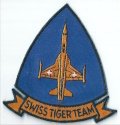 A
team of 13 ground technicians went to the USA for 5 weeks; two
pilots, including the Armament Service - Flight Test Center (Gruppe
für Rüstungsdienste - Flugversuche/GRD) chief
pilot, went
A
team of 13 ground technicians went to the USA for 5 weeks; two
pilots, including the Armament Service - Flight Test Center (Gruppe
für Rüstungsdienste - Flugversuche/GRD) chief
pilot, went
for five weeks in mid 1978 to Edwards AFB for tests
and evaluation flights. There were initially problems with the
braking system, insufficent on wet runways, and with the
unsatisfactory radar
during night flights.
Sub-assemblies for the first two aircrafts to be locally assembled arrived at Emmen on 30-11-77 on board of a Trans International Lockheed L-100.
Badge of Swiss Tiger Team (technical team) in USAFirst
Palmdale completed aircraft was the second frame (serial
J-3002), rolled out at Palmdale on 19-10-77, while the first Swiss
frame (serial J-3001) was first flown on 09-12-77. This aircraft
undertook all Swiss
specific tests and remained at the USAF Flight
Test Center, Edwards AFB, till at least July 1979 to complete the
test programm. First flight of a Swiss two-seater (serial J-3201)
followed on 07-03-78.
Consideration
was given to airfreight the Northrop-built aircrafts to Switzerland
but delivery on board USAF Lockheed C-5A Galaxy was less expensive;
Tigers were accepted by the USAF at Palmdale's Northrop
plant,
tested, flown to McClellan AFB where they were disassembled
and prepared for delivery between December 1977 and December 1979.
The
first Tigers arrived at Emmen AB on 22-08-78, five single- and one
double seaters. Additional deliveries by Lockhed C-5A followed on
21-09-78 and on 18-10-78, completing the first
part of the contract; all were
on boad of a Douglas C-5A and took
place at Emmen AB.
/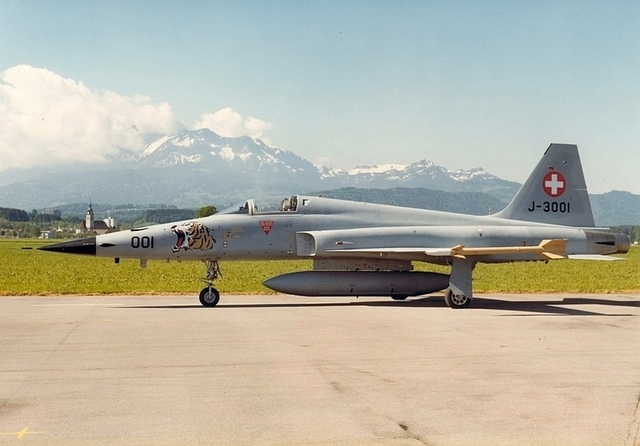 Photos: F+W
Emmen
Photos: F+W
Emmen
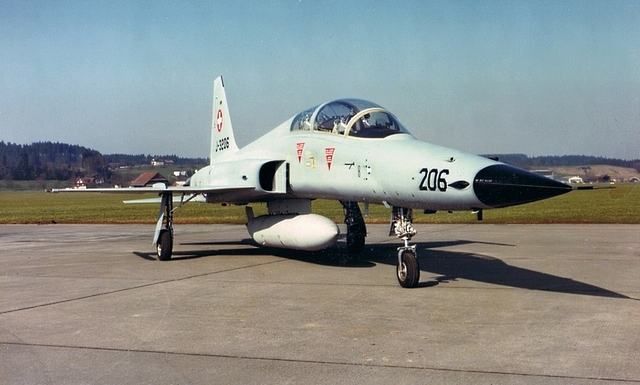
With
tiger painted on nose; of note early training AIM-9B
Sidewinder (nose
Clean View of the last first batch two-seate shortly before delivery
to the Air Force in 1979
sensor
only active) on wingtip. This weapon was actually rarely used by the
Tiger.
with non-standard white
underbelly tank.
Arrival
at Emmen AB of the first batch on 22-08-78
(four single- and two two-seaters) coincided with
the official roll-out of the first locally assembled aircraft (serial
J-3014), whose first flight took place on
29-08-78 from Emmen AB;
local assembly had started in January 1978, J-3015 an J-3016
were noted on the same date being
assembled. It needed approximately eight months for each frame to be
completed: the aircrafts reached the Air Force after having been
handed-over to the BAMF which checked its
status/operability and, if to its entire satisfaction,
accepted and readied for operation. The
complete spare-parts stock, consisting of 150 tons of aircraft and
ground equipment was delivered by October 1979. Radar
and navigation simulators were also bought. Second
delivery was at Emmen
on 24-09-78.
Air-to-air
missiles were used, initially in the form
of AIM-9B Sidewinders, followed by AIM-9E3 Sidewinders in 1974;
financing to upgrade these last to AIM-9P3 for sFr 75m was
granted on 18-09-78; newer
the AIM-9P-4 missiles were
received beginning 1988 and
later (1990 to 1995) modified to the P-5 versions.
SERVICE
INTRODUCTION
A Tiger Instruction Group, formed
by professional pilots, was established on 01-08-77 to ease the
introduction of the fighter and to develop new tactics as as well to
translate technical documentation in
German.
Basic
training of four professional instructors and one Federal
Office for Military Airports (Bundesamt für
Militärflugplätze/BAMF)
pilot started on 05-08-78 at Williams AFB with the
425th Squadron; of these,
the Swiss Air Force head instructor
and one instructor pilot attended the Fighter Weapons Instructor
course in November/December 1978. Air combat instructors were to
follow years later.
First
Northrop F-5E was handed over to the Air Force on 10-10-78, one month
ahead of schedule; by the end of 1978 eight had been accepted (4 more
than scheduled) which had flown a total of
29 hours.
First landing at other Air Bases was at Sion on
02-11-78, followed by Payerne AB on 24-01-79.
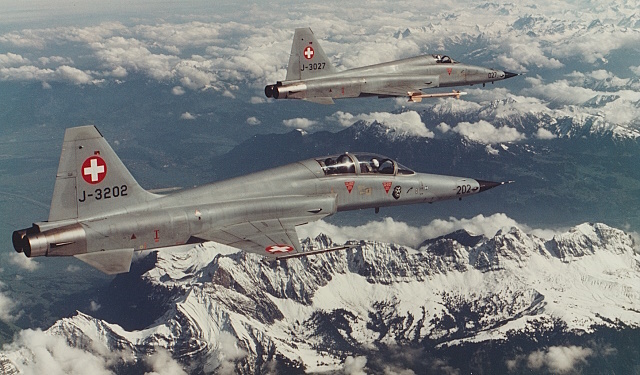 Photo: Swiss AF
Photo: Swiss AF
First batch Northrop F-5F serial J-3018 and Northrop J-3207; of note no VHF antenna, black radar radome
Twelve
pilots from Staffel 11 and four from Staffel 18 were the first ones
to be converted on the new fighter. Official first public appearance
was atr Zürich on 107-03-79, flying mock attacks by 7 single-
and 3 double-seaters.
All
six two-seaters, plus 16 single-seaters had been delivered on
11-04-79; 1'000 flying hours had been flown by mid 1979, more than
2'000 hours by the end of the year. Official hand-over to the Air
Force
was at Meirigen AB on 30-10-79.
The
three main peace-time bases (Payerne, Dübendorf, Meiringen) plus
Interlaken maintenance base were adapted to the Northrop F-5 and
conversion training of the first two professional Squadrons started
during 1979.
Official
hand-over to the two combat ready units, Squadron 11 and 18, took
place at Meiringen AB on 30-10-79, 25 single- and 6 double-seaters
had been handed over to the Air Force by this day. By
31-10-80
there were respectively 51 and 6 in use; seventy-two pilots
belonging to all four foreseen Squadrons had completed their
technical conversion and air combat training for a total of each 60
exercises
in approximately 6'000 flying hours; twenty 100 hours
checks had been undertaken on airframes. First militia pilots
conversion was at Payerne AB on Northrop F-5F, simulator was not
acailable. A Radar-
Training Cockpit (RATRA) was bought later,
without any visuals or motion possibility.
The
last aircraft was accepted by the Air Force on 09-04-81, when a total
of approximately 10'000 hours had been already flown by the fleet. Complete
maintenance and equipment independence had already
been reached
by March 1981.
Two Tiger equipped units were manned by pilots of the Surveillance Wing by 1981, one additional was in conversion in 1983; all three reached combat-ready status during March 1985.
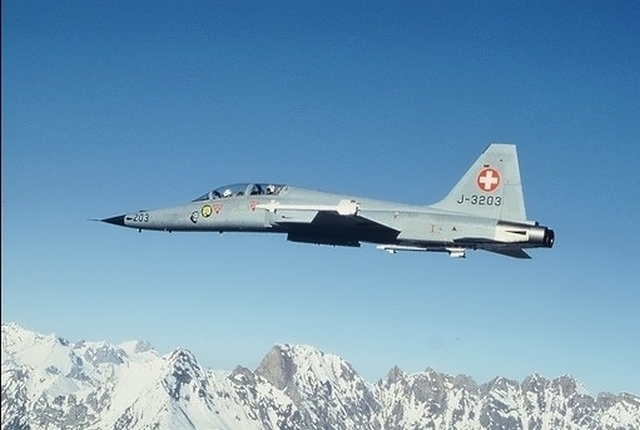 Photo: Swiss AF
Photo: Swiss AF
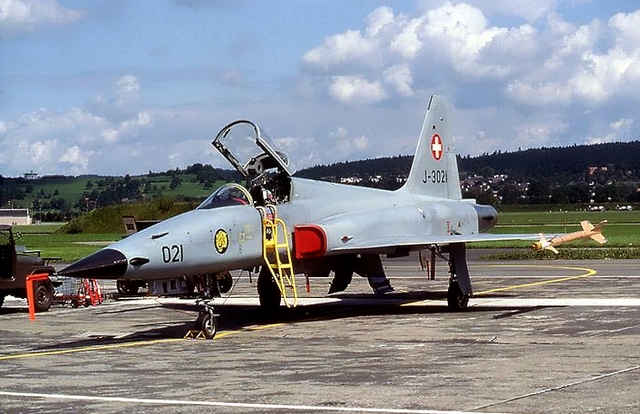
Northrop
F-5F J-3203 with badges of Squadron 11 and 18 flying over the Swiss
alps. This is one
of
Northrop
F-5E J-3021 at Dübendorf AB on 27-08-80 with Squadron 11 badge,
still without.
three
known to have been decorated with two Squadrons
badges.
nose
antenna
modification and VHF radio.
Loss
of the first Tiger (serial J-3013!)
took
place on 21-05-81 during an exercise involving 4 Northrop F-5E
protecting 4 Hawker Hunter Mk.58 fighter-bombers, due to the
collision with one of three Mirage IIIS
intercepting the
formation.
SECOND
BATCH ORDER, END OF PRODUCTION, MODIFICATIONS
The presence of three Squadrons equipped with very aged de Havilland Venoms dictated the urgent necessity to purchase additional Northrop fighters.
A
request for a second batch of 36 Northrop F-5E and 6 Northrop F-5F at
a cost of sFr 770 millions for two
Squadrons was approved by the parliament on
04-03-81. The price included munition, spare parts,
support
equipment and training support. An offset programm for Swiss products
for the value of around sFr 300m was foreseen. Only the first
single-seater was to be built at Palmdale, all the remaining
aircrafts
were to be assembled at the Swiss Federal Factory
in Emmen; their flaps, elevators, ailerons and rudders, for a value
of sFr 65m, were to be manufactured in Switzerland. The Palmdale
built aircraft touched
Swiss soil in Emmen
AB on 17-02-83, coming from Prestwick
(UK).
An
average of two airframes per month were subsequently assembled at
Emmen. Modifications to the first batch included a "shark"
nose, automatic slats and flaps plus a larger leading edge to improve
stall and
handling characteristics, particularly useful in the
mountains.
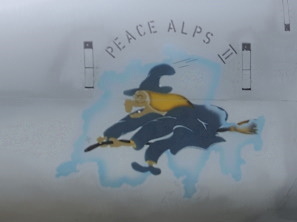
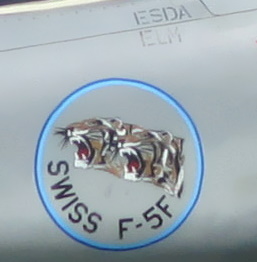
Last
aircraft of each type received an under-nose special painting; on the
left hand side (Peace Alps II), right J-3212
On
top of the J-3098 photo: inscription ELDA ELM used for radiation measurements flights.
The
same modifications were applied to aircrafts of
the first batch (see
here serial J-3062) starting from 1986 with a
programme taken care by F+W Emmen.
An VHF radio had already been added in 1982.
External
changes are clearly visible on above four-ship formation. The nearest
two aircrafts carry red painted Sidewinders and underbelly
tanks to be better visible in order
to avoid collisions during mock dog-
fightings. The ones in the
back ground have normal, yellow
paintedtraining missiles on the wingtips.
In
1985 4 "on-bord operators" of the 6 Staffel and 2 of the 18 Staffel
started training (mainly for navigation and radar duties); in 1990 they
were operational on Northrop
F-5F. This was following the USA experience in
South Vietnam. The pilot was
responsible to fly the aircraft amd the
operator for all other duties till the arrival of the McDonnell F/A-18,
when operators were responsible for Target Tug ane Electronic Warfare
against the
new aircrafts.
Swiss
Tiger programm came to an end on 27-03-85, when the last
single-seater was handed-over to the Air Force. Fly-away price of an
single-seater of the second batch was sFr 13m, of a double-seater
sFr
15m. Between 1978 and 1979 several Lockheed C-130 landed in Emmen
with aircraft kits. The Swiss factory needed an
average of 8 months for the assemblage of an airframe.
Compensation programms were completed by mid 1987: total value for the first batch reached USD 209m between 1975 and 1981, total value for the second batch USD 272m by 1987.
One two-seater (serial J-3209) was leased to Emerson Electric to show off a new radar, the APG-69, at the Le Bourget airshow in June 1985. This radar was not adopted by Switzerland.
During
the same month a contract was awarded to Northrop for full scale
development and production of the Northrop AN/ALQ-171(V)
Self-Defence ECM system. Unfortunately this
did not
come up to expectation and was abandoned at the end
of 1989. It was replaced in January 1993 by an order for
Ericsson Erijammer Vista 5A/100 to equip four Northrop F-5E
plus Pilatus PC-9s
for training purposes only, delivery started
in 1994.
Phase-out plans of Hawker Hunter in Swiss service led in 1990-91 to a fighter-bomber feasability (with 2 BL-755 cluster-bombs or rockets rails) of the Tiger aircraft. Two units were to have a
seconday ground-attack
role. The study highlighted the limited suitability of the aircrafts as
a fligher-bomber due to low armament carrying capability, high
modification costs (between 600
and 1000 millions Swiss
Francs) and late availability (1997/78). The contemporary purchase of
McDonnel F/A18 might have had influence on the negative decision. on
15-06-91 was the study
stopped as well as the purchase of Maverick air-to-ground missiles.
Another
specific Swiss Tiger modification was the adaptation of four Northrop
F-5E to tow for air-to-air shooting
the Saab MBV-2S dart target (formerly
used by Hawker Hunter Mk.58); first test flight took
place on 06-02-97, trials were completed by March 1997.
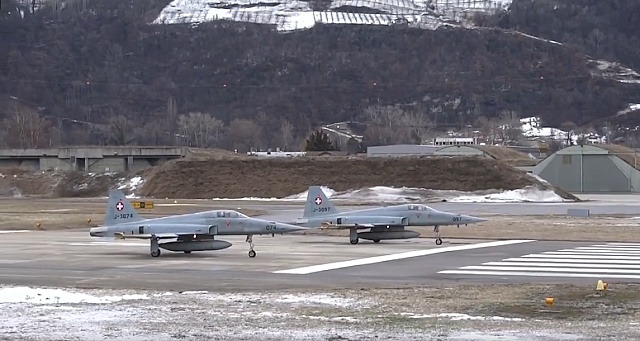
This picture of Sion AB gives an idea how the airports in narrow
valleys are!
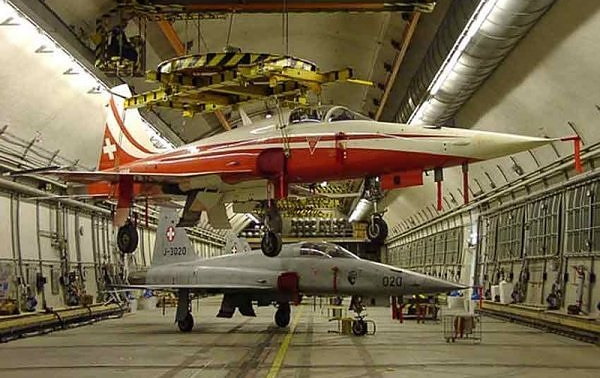
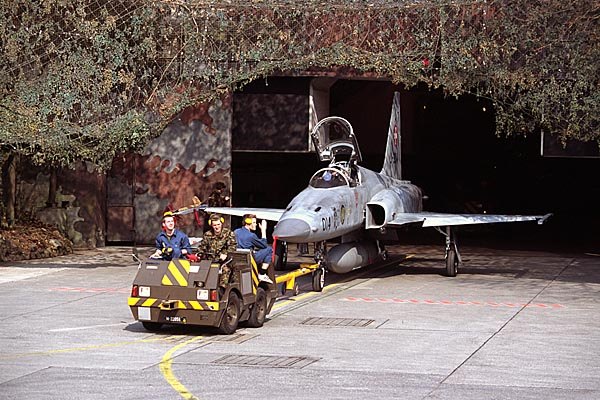
Storage
and aircrafts lifting in the
cavern...........
........... and being towed out at Turtmann AB
Aircrafts have been stored at mountain bases in caverns, here under Nothrop F-5E J-3041 being towed out of a well camouflaged one at Buochs AB on 29-04-03.
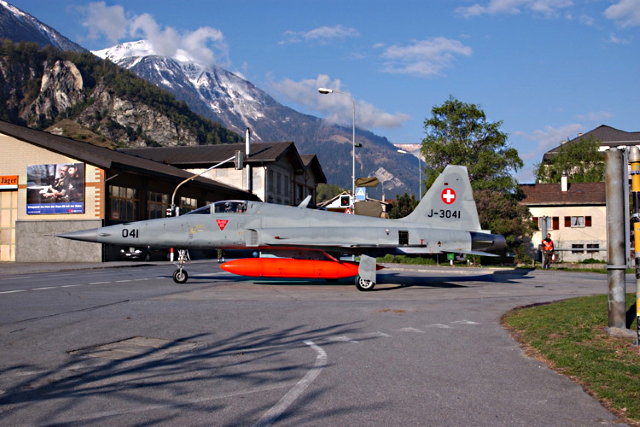
First batch Northrop
F-5E J-3041 modified to the latest standard, seen at Turtmann AB on
15-04-02 crossing
the town road to reach its caverns. another Swiss speciality! Clearly
visible is the two-grey camouflage.
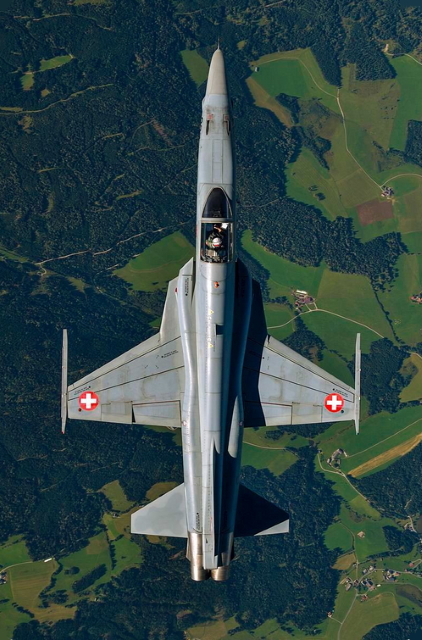
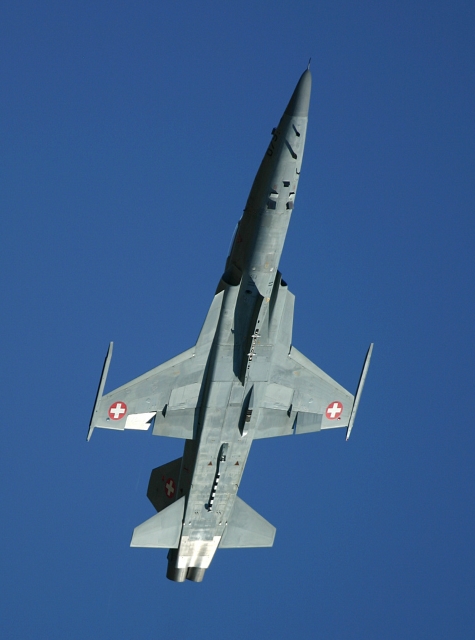
Very
clean over- and underwing view on an VHF radio and sharkmouth nose
updated Northrop F-5E Tiger
Photos:
Wilen Reto/unknown
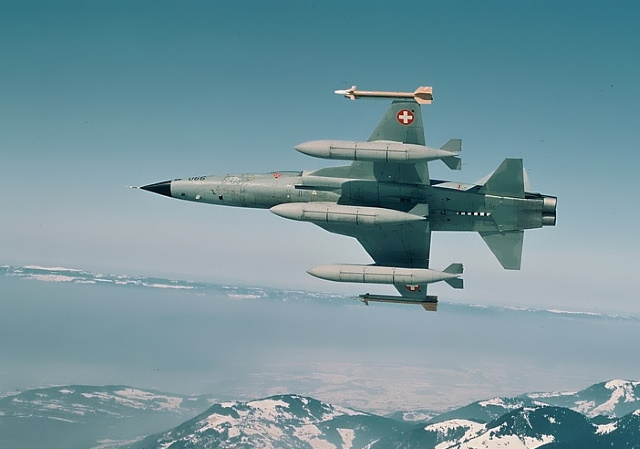 Photo:
Swiss Defence Department
Photo:
Swiss Defence Department
Final first batch Northrop J-3066 in an unusual configuration, 3x275
gallons tanks
underwings/underfuselage over the alps
Maintenance
A
civilian organisation, the Federal Office for Military Airports
(Bundesamt für Militärflugplätze, from 01-01-96
Bundesamt für Betriebe der Luftwaffe)
has been responsible for first and second level
mainte-
nance of the Tigers. Additionally to Air Bases
operations during peace-time maintenance was taken care during
emergency time by an Aviation Company (Fliegerkompanie/Companie
Aviation) at each
base. Main frames
maintenance was situated at Interlaken AB; Sidewinder air-to-air
missiles, together with General Electric J-85 engines,
maintenance was undertaken at Buochs/Enetmoos .
Modification of the nose cone was started in 1982 by the Emmen factory: a grey, flat cone was inserted together with an VHF antenna.
First
important check regarding the whole fleet was in 1997, due to lose a
bolt discovered on one aircraft; the discovery of fatigue cracks in
the wings and again of a defectuos bolt in 1997 brought a
serious crise: half of the fleet had to be grounded for some time. A
new check of all aircrafts' elevator had to be undertaken end of 2000
under an USAF directive; this reduced fighter availability for
two
weeks
 Photo: RUAG
Photo: RUAG
Maintenance of the Tiger was done by RUAG company at Emmen AB
Third level maintenance was provided by the Emmen factory till it was transferred to the Interlaken branch of the same company on 01-01-96.
The
100th main check was completed on
15-12-98, this
airframe
(J-3066) received on this occasion a special decoration
on
the tail tha twas removed
on returning the
aircraft to the Air Force.
AIR
FORCE RESTRUCTURATION / OPERATION WINDING DOWN
General reduction of military expenses came with the end of Cold War, together with a wide ranging restructuration programm, beginning during 1995, completed in 2005.
The
Tiger fleet was scaled down from 101 to 85 active aircrafts in 1998,
16 were put in storage, while the last night flights were stopped
during the same year.
The last airframe overhauled at Interlaken
AB left the base on 22-12-99, shortly before this base was closed to
jet operations on 31-12-99. This aircraft received a special
undernose painting to comme-
morate the two events.
McDonnel
F/A-18s re-equipped in 1998 and 1999
two Northrop F-5E Squadrons while a second
reduction round started on 31-12-03 with the disbandment of two
Squadrons and the withdrawal of
another 31 aircrafts (54 remaining
in use). All forty-six redundant
Northrop F-5E were put up for sale (an aircraft had been damaged
and withdrawn from use earlier).

Four
permanent Tiger bases (Dübendorf, Payerne, Meiringen,
Interlaken) were kept operational; some were closed (Mollis,
Turtmann, Interlaken), placed on a "sleeping" status
(Buochs) or kept for helicopter
use only.
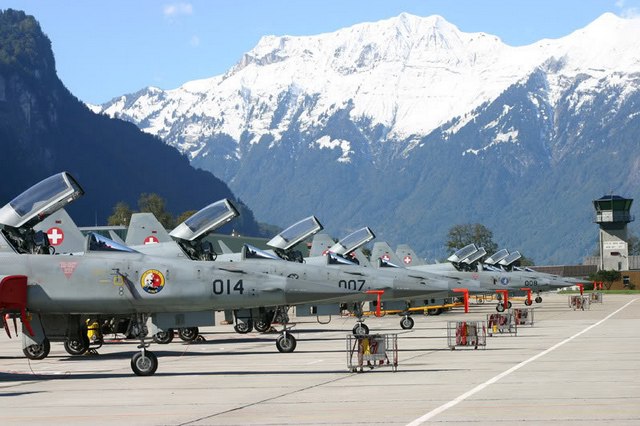 Photo:
unknown
Photo:
unknown
Line-up
at Meiringen AB in a typical Swiss alpine background.
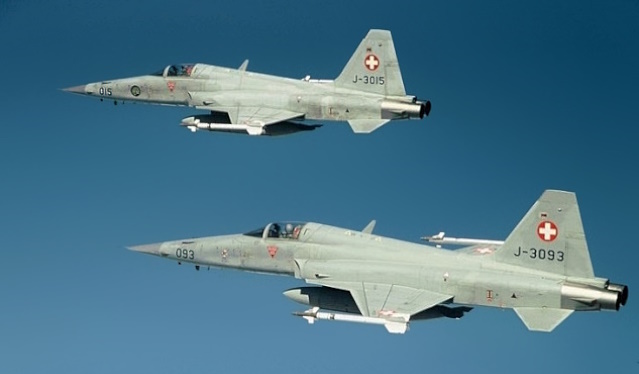 Photo: Swiss AF
Photo: Swiss AF
Northrop F-5E combat patrol with active Sidewinder AIM-9
A last upgrade in communication technology took place in 2000: Have Quick I radios were installed in the aircrafts to make them compatible with McConnell F-18s.
Twelve Northrop F-5F were kept for general services, electronic warfare and advanced pilot training - a new duty following retirement of the Swiss BAe Hawk on 13-12-04.
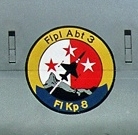
Badge
of Turtmann AB' ground crew (Air Base Section 3, base
maintenance/Aviation Company 8, aircrafts maintenance) painted on
some Tiger's nose to remember the closure of
this base on
31-03-03.
Jet aircrafts operation out of Dübendorf
AB (the first ever Swiss base) ended on 31-12-05, reducing
operational bases to three. Five single- and four double-seaters
based there were distributed among
other bases on 15-12-04.
The
year 2009 saw the grounding of four double-seaters when
they approached the need for major servicing: Pilatus PC-21 took over
the advanced jet pilot training in mid 2008; four were to be flown
only up to the moment
they needed main checks and maintained flying able with a minimum of
servicing. The remaining four active ones were to be kept for Target
Towing and Electronic Warfare and
militia pilots training.
The
Tiger fleet reached the goal of 250'000 flight hours in January
2010.
At the end of November 2014 the Air Force had 42
Northrop F-5E and 12 Northrop F-5F on strength; of these 36 machines
were operational. Eighteen aircrafts needed in-deep maintenance,
which was
not foreseen.
Wiithin the next 2 years in-deep
maintenance was necessary on 2 single- and 8 double-seaters but
they were only to be flown up to the end of their flying hours, while
minimun maintenance was to keep
on them as a reserve in order to
be again available in case of necessity.
.
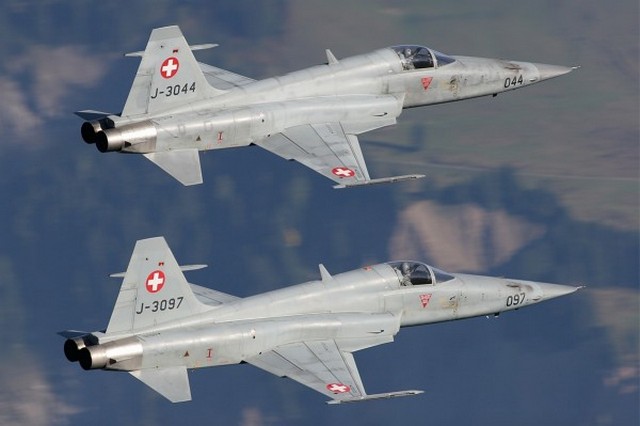 Photo:
Dirck Voortmans
Photo:
Dirck Voortmans
.
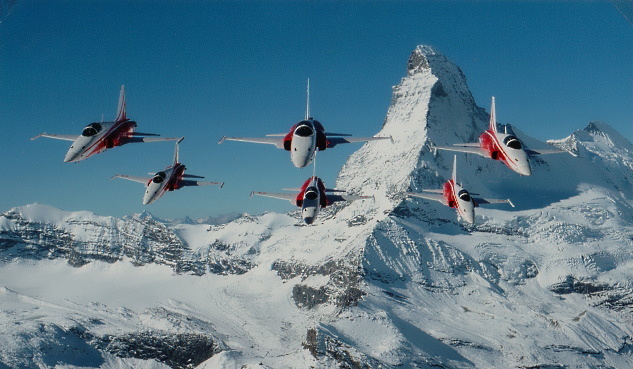 Photo: Defence Department
Photo: Defence Department
RUAG
Aviation and Space, former Eidgenössischen
Flugzeugwerk Emmen (EFW)/S+F Aerospace
RUAG Aviation and
Space was formed on 01-01-99, in the wawe of the restructurating
as a holding company comprising the aircraft factory at Emmen plus
additional aviation related factories responsible for
manufacturing, maintenance, repair and overhaul of aircrafts and
instruments. The factory is still in charge to repair and maintain
the Swiss F-5 fleet; it has signed a roaming agreement with Northrop
Grumman to provide additionally worldwide support, modification
and upgrade programms to countries still flying the
aircraft.
AIRCRAFT SALE/LEASE
Brazil
Signed a Memorandum of Interest on 15-10-02 for 16
Northrop F-5E, 8 to be modified as double-seaters; it modified later
its request wishing original Swiss double-seaters; this request was
rejected as
these were not up for sale. A Swiss offer, in 2003, to
transfer 2 F-5F and 14 single-seaters was not accepted.
US
Navy More luck had the sale of an initial
lot of 32 single-seaters from the first batch for a price of sFr 25m;
a contract was signed on 07-03-03. These were aircrafts in need of a
general overhaul having
flown between1'800 and 2'400 hours. They
were to be modified according to US Navy wishes and restored to
flying capability by Grumman Northrop before being transferred to US
Navy and US Marines
aggressor units.
The
sale was endangered for some time by the restrictions to arms exports
imposed by the Swiss government following US invasion of Iraq on
30-03-03; but these were cancelled in mid-April. The first aircraft
left Emmen on board of an US Navy Lockheed C-130T on 02-05-03.
Only five were delivered in 2003 due to US Navy budgetary problems,
seven followed in 2004.
Sixty General Electric J-85 engines were
overhauled at Emmen by RUAG, while an additional 18 were sold as
reserves.
Twelve additional single-seaters were optioned in small
batches, bringing total costs to USD 50m; options were later all taken
up bringing thr tptsl to 44 aircrafts bought.
.
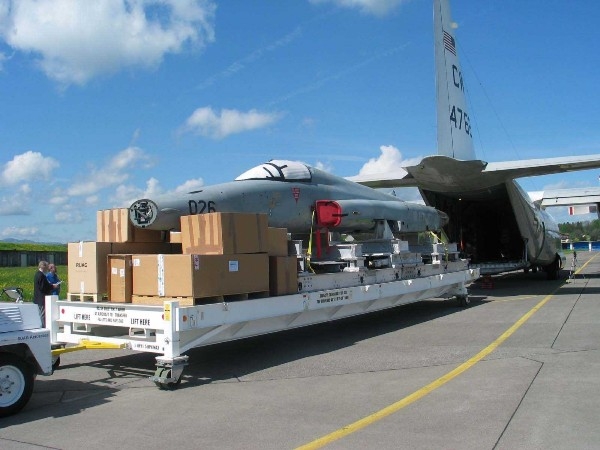 Photo: US
Navy
Photo: US
Navy
Loading the first US Navy aircraft, serial J-3026
at Emmen on 02-05-03
Twenty
five aircrafts had been delivered to the US Navy by April 2006; the
very last Tiger (serial J-3025) left
Emmen on 13-11-07, being airfreighted to Northrop-Grumman's facility
at St. Augustine, Florida, on a
US Navy C-130T.
Interestingly, three former Swiss aircrafts were modified to double-seater by Grumman Northrop.
Swiss
Governement requested authorisation in 2018 to withdraw from use 27
of 53 remanining F-5s; purchase interest was shown by the US Navy,
though the aircraft had been out of service since some years and
had
no flight-hours left. They had to be accordingly overhauled for
further utilisation. Maintance/control costs for the stocked
aircrafts in Switzerland was 600' 000 Swiss Francs each
year.
Discussions for an additional sale of 22 Northrop F-5
started in July 2019 but were not concluded by January 2020.
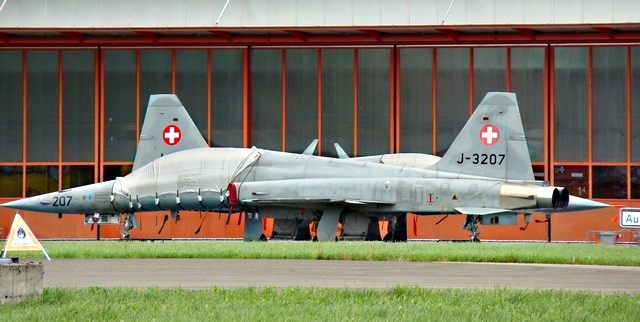 Photo: archive the Northrop F-5 Enthusiast
Photo: archive the Northrop F-5 EnthusiastNorthrop F-5F J-3207 stored at Meiringen AB awaiting sale on 09-08-11. In the background an Northrop F-5E, also withdrawn from use.
Unofficial
sources reported in 2014 that 18 aircrafts were to be sold to the USA,
the contract to be finalised by the end of 2014;
A request to buy additional 22
ex-Swiss Tigers has been rejected in the 2020 Fiscal Year, discussions for additionl 22 aircrafts started in
July 2019 but not concluded by January 2020, Value stated to be USD
40m
and delivery expected by 2021. By mid-20 there were at least
10 Northrop F-5 2 Northrop F-5F, 8 F-5E) stored at Emmen
AB, later stocket at Däbendorf AB.
Austria
Not a sale but a lease was arranged in
mid-February 2004; 12 Northrop F-5E were leased for four years, with
an option for extension of a maximum of two years. The contract was
signed at the end of
April 2004 with the Swiss armament Agency
"Armasuisse" to the approximate cost of Euro 14m per year.
This included logistics for the Austrian main and reserve base
(Graz-Thalerhof and Linz-Hörsching), docu-
mentation,
armament, training of flight and maintenance crews as well as
maintenance of the aircraft by RUAG at Emmen.
The first four aircrafts (serials J-3005/30/33/65) were trasferred from Emmen to Graz-Thalerhof on 07-07-04, officially accepted on 09-07-04; the last (serial J-3014) followed on 14-12-05.
All former Austrian Tigers were returned, starting on 30-06-08, ending on 24-07-08; ten are confirmed to have been returned to Swiss service.
SEARCH FOR A SUCCESSOR
Northrop F-20 82-0062/N4416T was demonstrated unofficially to the Swiss military authorities at Emmen AB on 20-09-83 as a possible successor to the Tiger but did not arouse local interest.
Initial
thoughts for a replacement fighter were made at the beginning of the
2000's; an offer by Israel's IAI
to modernise the remaining Tigers in order to
keep them operational till 2020 at a
rather low cost
was not accepted.
Instead, fourth generation fighters were taken into consideration, starting a very controversial selection exercise/saga.
Offer
were requested for Saab JA-39 Gripen, Boeing F-18E/F,
Dassault Rafale, Eurofighter Typhoon; these (with the exeption of the
Boeing F-18E/F) were tested in depth in Switzerland in 2008 but lack
of
finance postponed several times
the definitive selection till 2012, meaning that
the good, old Tiger remained in use (this without any in-depth
upgrade!).
At
present Northrop F-5Es are used as "aggressors"
against McDonnell F/A-18s and
as targets for the Swiss Army anti-aircraft units as
well as for relieving the more modern
fighters from general air policing
duty during day-time.
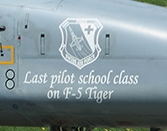
In
the meantime Swiss Tiger pilots
training
has
been discontinued in 2007; some aircraft obtained the logo
shown here to commemorate the end of the last F-5
pilot
school class ended mid 2008, being replaced on Piatus PC-21. No
new militia pilots will be trained, some Hornet pilots wii be
retrained on the Tiger.
Surprisingly,
a request to check feasibility to extend the life of Tigers
(approximately 30) for 15 to 20 years (up to 2031!) was issued by the
Swiss Defence ministry on 20-04-11, just in case the purchase
of a
new fighter would be delayed.
On 30-11-11 the Swiss government announced it had decided to purchase 22 Saab J-39 Gripen as the Tiger successor, though this selection was highly contested.
Approval
by the Swiss parliament for
the purchase was given in automn 2013 but a referendum was set for
18-05-14 for the definitive approval of fundings by Swiss people.
Funds for the purchase of the
Saab Gripen were denied and by
mid-June 2014 a new appraisal to keep the Tigers left in service
for approximately another 10 years (with modifications) was requested
by the Swiss parliament. This was
informed on 29-08-14 that the
costs for upgrading Northrop F-5s would vary between 900m SFr (day
only, minimal instrumental/night operations) and 1.2 billions (for
full air defence equipment day/night
operations), both costs being
const dered too expensive. Mid February 2022 was annouced that the Tigers should be retired between
2016 and 2018 and put on sale.
A
crack on an aircraft's supporting structure was found during a major
overhaul in 2014, followed by another aircraft in January 2015; the
Air Force ordered subsequently an inspection on the entire
fleet,
completed in April 2014.
On
20-04-15 it was officially mentioned that 36 (out of 54)
Tigers were serviceable plus 16 where cracking had
been discovered; 6 would be repaired and returned to service while 9
single- and 1 double-
seater would not be reapared. Repaired are
from 2016 F-5E J-3073, J-3082, J-3093, J-3094, J-3095 and Northrop
J-3201. By August 2015 there were 11 in
Patrouille Suisse colours acrobatic team
aircrafts, 11 grey Tigers
and 4 double-seaters.
Another source metioned in January 2015
that only 36 aircrafts are operational, additional 18 are needed deep
maintenance (not to be done). Only 22 single- and 4 double-seater
were to be maintained
in use. Two Northrop F-5E and 8 F-5F were to
have in-depth maintenance in 2016 and 2017 but only the remaining
hours would be flown by the aircrafts, followed by a reduced
maintenance to keep them
operational for emergency situations
only. They will not be in normal/training Squadron use.
Six withdrawn from use Northrop F-5E and F-5F were parked in April 2015 in the open air at Emmen since months due to missing space availability in the hangars.
The
minister of defence proposed that the Air Force to buy a number of
Gripen C and D in 2016 but this was not realised. According to
statements in September 2015 a new evaluation for 22 (or more)
fighters had to take place; the Saab Gripen was withdawn from the
competition by Saab and the EADS Rafale, the Lockheed Martin F-35 and
the Boeing F-18 were still on the list of a possible purchase, to
be
selected in 2020.
Three
Northrop F-5Es units have been disbanded by the end of 2017, two
being reformed following year to operate the remaining 22 single- and
4 double-seaters (service aircrafts) used to retain pilot
proficency,
as ECM training aircrafts and as adersary for McDonnell F/A-18s, foreseen
to last till at least 2025. The acquisition of 20 mm ammunition
has been stopped due to budgetary problems; the
fate
also for the Sidewinders AIMP-9J Sidewinder and that of 15
F-5s and 9 F-5Fs retired (mainly stored at Emmen) has still to
be decided. Northrop F-5s used for Electronic Warfare instruction
were withdrawn
on 31-12-17.
Sion
AB (Base Ariénne 14/Air Base 14) was closed as an operational
base after the last militia refresher course ended on 25-01-17. It
still is used as a reserve basis, though originally planned to be
completely
closed to all military jets.
The last shooting
demonstration for the Tiger was held at the yearly Axalp show on
10-10-18, as the aircrafts will only be used as service (ancillary)
aircrafts; but Northrop F-5E will be still there in form of
the
Patrouille Suisse acrobatic demonstration unit.
End of 2021 there were 18 Northrop F-5 in use of which 10 were in Patrouille Swiss colours. For details of confirmed serials see Northrop F-5 and Northrop F-5F serials page.
By 01-08-19 the Tigers were foreseen to be kept in use till 2025; by February 2022 there were 20 single- and 5 two-seaters on strength. Operation of 10 single- and 2 double-seaters behind the year 2025
would cost 9 millions Swiss Fracs owing to replacement of the INS and
avionics components plus 25 million Francs operation costs each year.
A successor to both the Tiger and to the MxDonnell Douglas was finally selected in the form of the Boeing F-35 and a contract for 36 was first provisionnally signed, confirmed in March 2023.
First Northrop aircraft of the secon batch left Switzerland (Emmen AB) on board an US Marines Lockheed KC-130J